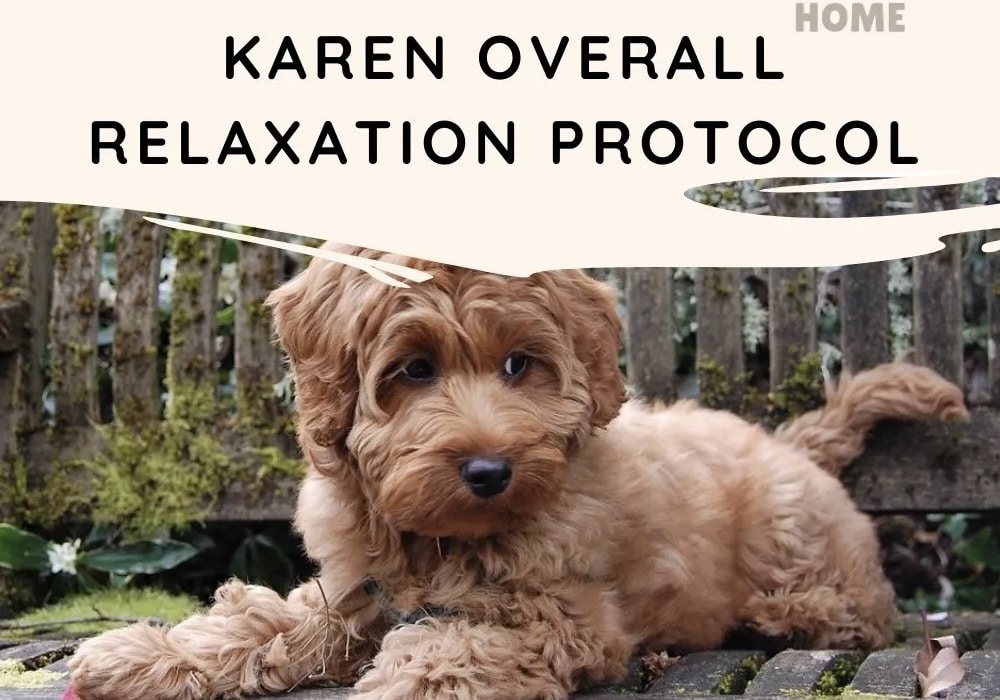behavior modification, counter-conditioning and desensitization, Dr. Karen Overall, Relaxation protocol for dogs
What is the Relaxation Protocol for Dogs?
Picture courtesy of Labradoodle Home
What is the Relaxation Protocol for Dogs?
What is the relaxation protocol for dogs? By Will Bangura, M.S., CBCC-KA, CPDT-KA, (Dog Behaviorist) Certified Behavior Consultant. Relaxation protocols have been developed for dogs who exhibit anxious, fearful, and aggressive behavior. Karen Overall, a renowned veterinary behaviorist, has created a relaxation protocol to reduce dogs’ anxiety. This protocol can help dogs with separation anxiety, fear of loud noises, or anxiety around unfamiliar people or situations. The relaxation protocol involves a structured training program that helps dogs to learn how to calm down and relax in stressful situations. In this article, we will provide a detailed overview of the relaxation protocol created by Karen Overall.
What is the Relaxation Protocol for Dogs?
The relaxation protocol is a training program consisting of exercises designed to teach dogs how to relax and remain calm in stressful situations. This protocol was developed by Karen Overall, a veterinary behaviorist who has spent over 30 years researching and treating behavioral issues in dogs. The relaxation protocol is designed to help dogs overcome anxiety, fear, and aggression by teaching them how to remain calm and focused in stressful situations.
The protocol consists of a series of exercises to be completed in a specific order. Each exercise builds on the previous one, gradually increasing the dog’s ability to remain calm and focused. The protocol can be used in various situations, such as when the dog is left alone, during thunderstorms, or when meeting new people.
The exercises in the relaxation protocol are designed to help the dog learn to relax by combining physical and mental exercises. The exercises are designed to be done in a specific order and at a specific pace. Each exercise is designed to build on the previous one, gradually increasing the dog’s ability to remain calm and focused.
How Does the Relaxation Protocol for Dogs Work?
The relaxation protocol teaches the dog to remain calm and relaxed in stressful situations. The protocol is designed to help the dog learn to control its emotions and stay focused, even when experiencing stress or anxiety.
The relaxation protocol for dogs teaches the dog how to remain calm and focused in a controlled environment. This is done through a series of mental exercises involving the dog performing specific tasks, such as sitting and staying calm and focused.
The protocol teaches the dog to remain calm and focused in real-life situations. This is done by gradually introducing the dog to more stressful situations, such as loud noises or unfamiliar people. The dog is then taught to remain calm and focused in these situations using the skills it has learned through the protocol.
The relaxation protocol is designed to be used over several weeks, with each exercise being repeated several times a day. The protocol is designed to be done in a specific order and at a specific pace, with each exercise building on the previous one.
Benefits of the Relaxation Protocol.
The relaxation protocol has been shown to have several benefits for dogs with anxiety and other behavioral issues. Some of the benefits of the protocol include the following:
Reduced anxiety in Dogs.
The relaxation protocol can help reduce dogs’ anxiety by teaching them how to remain calm and focused in stressful situations.
Relaxation Protocol for Increased confidence in Dogs.
By teaching the dog how to remain calm and focused, the relaxation protocol can help to increase the dog’s confidence in itself and its abilities.
Improved behavior.
The relaxation protocol can help to improve the dog’s behavior by teaching it how to control its emotions and remain calm in stressful situations.
Better health by reducing anxiety and stress; the relaxation protocol can also help to improve the dog’s overall health and well-being.
Criticisms of the relaxation protocol.
While the relaxation protocol created by Karen Overall has been widely praised for its effectiveness in reducing anxiety and improving behavior in dogs, some criticisms of the protocol should be considered.
One criticism of the relaxation protocol is that it may not suit all dogs. Some dogs may find specific exercises too difficult or become too stressed during the protocol. It is important for dog owners to monitor their dog’s reactions during the protocol and modify the exercises to suit their dog’s needs.
Another criticism of the protocol is that it may not address the underlying causes of a dog’s anxiety or behavioral issues. While the protocol can help to manage symptoms and improve behavior in the short term, it may not be enough to address the root causes of the problem. Dog owners need to work with a veterinarian or animal behaviorist to identify and address any underlying issues contributing to their dog’s anxiety or behavioral problems.
Finally, some critics have suggested that the protocol may not be as effective for severe anxiety or behavioral problems. While the protocol can be helpful for many dogs, some dogs may require more intensive behavioral therapy or medication to manage their symptoms.
While there are some criticisms of the relaxation protocol, it remains a highly effective tool for many dog owners looking to improve their dog’s behavior and reduce anxiety. By working with a veterinarian or animal behaviorist and closely monitoring their dog’s reactions, owners can use the protocol to help them learn to remain calm and focused in even the most stressful situations.
The relaxation protocol is a highly effective tool for reducing dogs’ anxiety and other behavioral issues. Using a combination of physical and mental exercises, the protocol teaches dogs to remain calm and focused in stressful situations. The protocol is designed to be done in a specific order and at a specific pace, with each exercise building on the previous one.
The relaxation protocol has been shown to have several benefits for dogs, including reduced anxiety, increased confidence, improved behavior, and better overall health. It is a highly effective tool for treating separation anxiety, fear of loud noises, and anxiety around unfamiliar people or situations.
Overall, the relaxation protocol is an important tool for any dog owner looking to improve their dog’s behavior and overall well-being. By following the protocol and working with their dog regularly, owners can help their dogs to learn to remain calm and focused in even the most stressful situations. In more serious cases, you may need to consult with an animal behaviorist, veterinary behaviorist, or dog trainer.
References.
Overall, K. (2010). Relaxation protocol. Veterinary Clinics: Small Animal Practice, 40(2), 297-302.
Blackwell, E. J., Bradshaw, J. W., & Casey, R. A. (2013). Fear responses to noises in domestic dogs: Prevalence, risk factors and co-occurrence with other fear related behaviour. Applied Animal Behaviour Science, 145(1-2), 15-25.
Flannigan, G., & Dodman, N. H. (2001). Risk factors and behaviors associated with separation anxiety in dogs. Journal of the American Veterinary Medical Association, 219(4), 460-466.
Mills, D. S., & Redgate, S. E. (2016). Behavioral and physiological responses of dogs to variation in visual and auditory stimuli in an animal behavior test. Journal of Veterinary Behavior, 12, 31-38.
Blackwell, E. J., Bradshaw, J. W., & Casey, R. A. (2014). Fear responses to noises in domestic dogs: Prevalence, risk factors and co-occurrence with other fear-related behavior. Applied Animal Behaviour Science, 152, 52-63.


